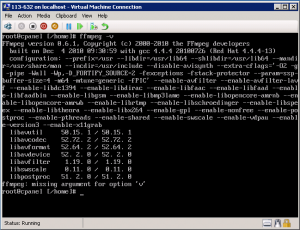


Rpm -ivh rpmforge-release-0.5.x86_64.rpmĬode: Select all yum install yasm faad2 faad2-devel opencore-amr opencore-amr-devel libtheora libtheora-devel a52dec a52dec-devel lame lame-devel x264 x264-devel faac faac-devel dirac dirac-devel xvidcore-devel xvidcore ffmpeg ffmpeg-devel ffmpeg-libpostproc libvorbis libvorbis-devel mplayer mencoder directfbĬode: Select all =Ī52dec-devel i386 0.7. rpmforge 23 kĭirac-devel i386 1.0. rpmforge 918 kĭirectfb i386 1.2. rpmforge 3.5 Mįaac-devel i386 1. rpmforge 5.6 kįaad2-devel i386 2. rpmforge 9.5 kįfmpeg-devel i386 0. rpmforge 2.6 Mįfmpeg-libpostproc i386 0. rpmforge 40 k Through this tutorial, we have learned how to install and use FFmpeg on centOS 8.Recently it became available to use binary packages for FFmpeg and other related codecs for media content management without need to compile all of them from the sources. Now, Verify the FFmpeg installation by executing the following command on command line or terminal: ffmpeg -version Step 4 – Uses of FFmpegįinally, we will look at some basic examples on how to use the ffmpeg utility.Ĭonvert a video file from mp4 to webm: ffmpeg -i input.mp4 output.webmĬonvert an audio file from mp3 to ogg: ffmpeg -i input.mp3 output.ogg Once the repositories are enabled, Then execute the following command on command line or terminal to install FFmpeg: sudo dnf install ffmpeg Sudo yum-config-manager -set-enabled PowerTools Step 4 – Uses of FFmpeg Step 1 – Enable EPEL and PowerTools repositoriesįirst of all, open command line or terminal and execute the following command into it to enable epel and powertools repositories in centOS 8: sudo dnf install epel-release dnf-utils.Step 3 – Verify the FFmpeg installation.Step 1 – Enable EPEL and PowerTools repositories.Just follow the following steps to install and use FFmpeg on centOS 8: With FFmpeg, you can convert between various video and audio formats, set sample rates, capture streaming audio/video, and resize videos. It contains a set of shared audio and video libraries such as libavcodec, libavformat, and libavutil. Install and use FFmpeg on centOS 8 Through this tutorial, we will learn how to install and use FFmpeg on centOS 8.įFmpeg is a free and open-source collection of tools for handling multimedia files.


 0 kommentar(er)
0 kommentar(er)
